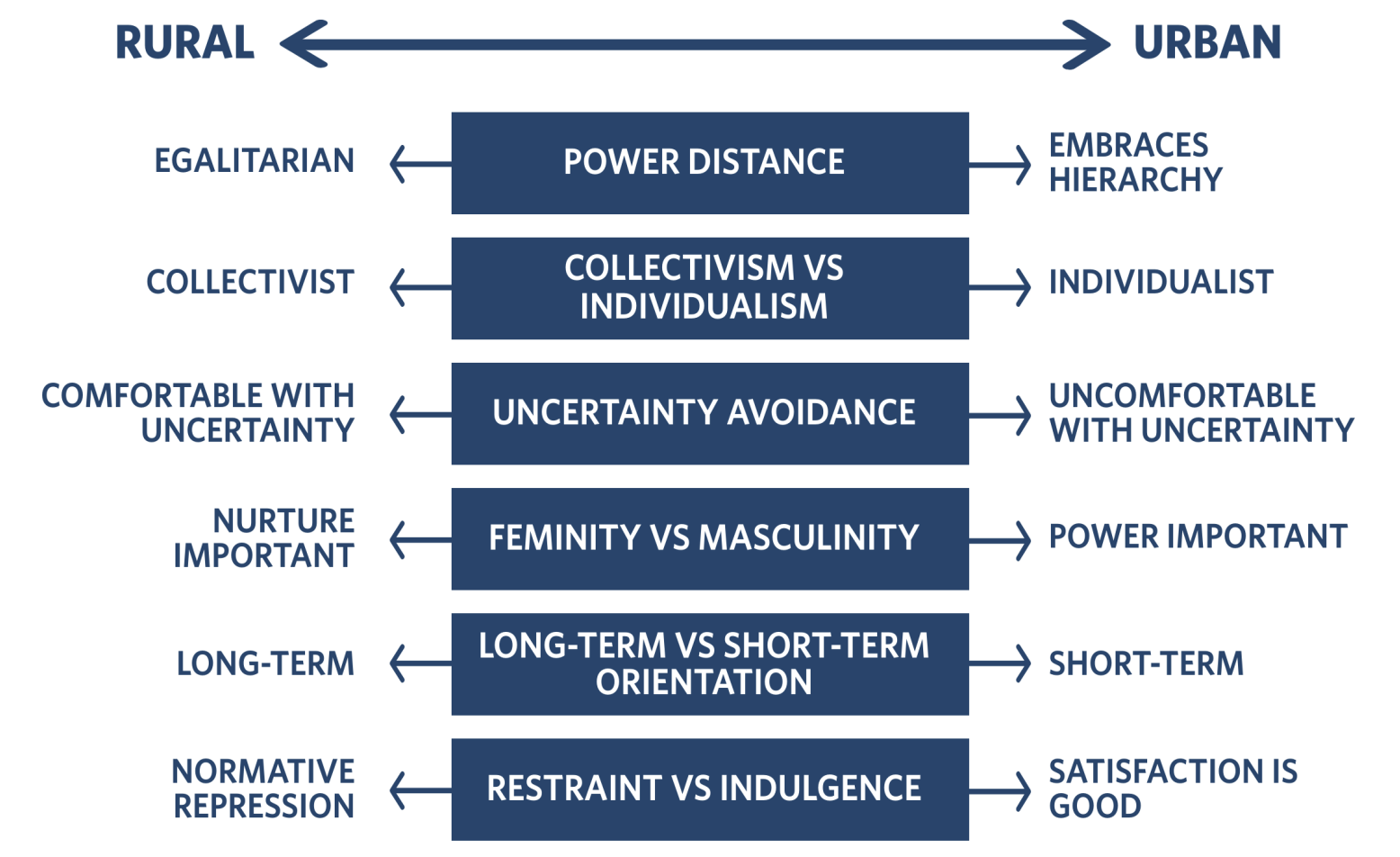Key Cultural Values as Influencers of Pro-environmental Behaviour
There is a large body of knowledge describing the relationship between culture and behaviour, with Geert Hofstede being a prominent leader in the field. He defined culture as “the collective programming of the mind distinguishing the members of one group or category of people from others” and established the Model of Cultural Dimensions. This model emphasizes six main pillars of national culture: power distance; collectivism vs individualism; femininity vs masculinity; uncertainty avoidance; short-term vs long-term orientation; and indulgence vs restraint.11
Hofstede’s research argues that these cultural values are key influencers of an individual’s beliefs and attitudes which, in turn, shape social behaviours. The application of Hofstede’s cultural dimensions, particularly collectivism vs individualism and long-term vs short-term orientation, can be used to understand and promote pro-environmental behaviour by 1) identifying the dominant cultural orientation at play, 2) determining cultural transformations that will encourage the adoption of sustainable practices, and 3) devising and implementing strategies to drive forward the desired cultural shift.6 Figure 6 shows these cultural dimensions in reference to rural and urban belief structures. This is a simplistic generalization that is by no means representative of individual attitudes but rather is intended to only outline a possible explanation of the differences between rural and urban when it comes to collective action and climate advocacy.

Elyse Tsang discusses ways in which pro-environmental behaviour can be encouraged and the relationship between behaviour and values (3:05)
Collectivism
Collectivism and individualism are cultural orientations that describe the degree of interdependence within a society and are based on how individuals relate to the larger community. Collectivist societies are characterized as highly integrated and cohesive, while individualistic societies have a greater focus on independence and personal benefit, even at the community’s expense. In this way, individualism values self-fulfillment over group goals, whereas collectivism centres on harmony and unified well-being.
Based on these defining qualities, individualism is more strongly associated with climate inaction, while collectivism is presumed to play a particularly influential role in shaping pro-environmental behaviour because it corresponds to cooperative values reflected through people’s connection to society and their surroundings.12 On this account, collectivists exhibit increasingly positive attitudes towards civic cooperation and sustainability, which more likely translate into the engagement of climate-conscious behaviour.6 For instance, individuals in collectivist societies have demonstrated a greater willingness to pay higher taxes in the interest of protecting the natural environment.13
Rural communities are predominantly collectivistic in nature due to the influence of several defining characteristics such as small population size, remote geography, and strong social connections.14 Accordingly, they can draw on the strengths of this dominating cultural orientation to promote the adoption of pro-environmental behaviour and climate adaptation strategies which are key to enhancing transformational resilience at the community level. Through these mechanisms, collectivism acts as a mediating force to increase the coping capacity of rural communities to ecosystem disruption, ultimately contributing to the generation of improved rural health outcomes.
The collectivist nature of rural communities should be drawn upon to promote the adoption of pro-environmental behaviour and climate adaptation strategies which are key to enhancing transformational resilience at the community level
Long-Term Orientation
Long-term orientation represents the extent to which society engages in forward-looking behaviours such as planning, saving, and conserving, and is related to the prioritization of present sacrifices that will generate future rewards. In contrast, cultures with short-term orientation are driven by immediate gratification and are less focused on the long-term consequences of their actions. They exhibit less concern over future well-being and place a greater emphasis on present needs.6
Considering that long-term approaches are inherent to sustainability efforts, longterm-oriented societies are more likely to invest resources, time, and energy into environmental protection compared to those characterized by short-term orientation. As such, longterm orientation has been more strongly associated with pro-environmental attitudes and intentions that underpin the engagement of climate-protective behaviours, for example, making green purchases and implementing corporate policy to meet environmental objectives.12,15 Long-term orientation has also been linked with increased national success in protecting biodiversity and preventing habitat loss.16
For rural communities, small population sizes and isolated conditions facilitate the necessity for strong connections between people. In particular, rural communities often emphasize intergenerational relationships as these are the avenues by which community knowledge is transferred.17 This value associated with intergenerational collaboration contributes to a collective understanding that present actions inevitably affect long-term outcomes and future generations down the line, thereby forming the grounds for long-term oriented goals.18 In the context of climate action, these forward-looking goals should include promoting sustainable practices to protect the environment for generations to come.

Human-Nature Relationship and Connection to Place
Aside from Hofstede’s cultural dimensions which are intimately related to collectivism and long-term orientation, there is the concept of connection to place. This cultural value describes the close relationship people share with the land, water, and history of their surrounding environment. Connection to place plays a particularly significant role in Indigenous and rural communities as these populations are highly dependent on their natural environment for their livelihoods, health, social structures, and overall well-being.19 In contrast, urban societies typically reflect a weaker human-nature relationship that stems from human dominance over nature.20 This can be attributed to the fact that urban settings are more geographically removed from the natural environment, despite the reality that many aspects of urban living, such as food supply, energy sources, and production of goods, heavily rely on the accessibility of natural resources.
There is an urgent need for a widespread cultural transformation that revalues our natural systems and acknowledges the need to promote respectful engagement with our environment, including the species we share our planet with. As demonstrated by Indigenous and rural communities, a strong connection to place can serve as a guide to reform many of the current maladaptive attitudes and behaviours towards climate change, improving human health.21
Blaine Grinder discusses the issue of ‘what we don’t see’ when it comes to climate change, the values that are important in adaptation, and the need for Indigenous partnerships (1:42)

